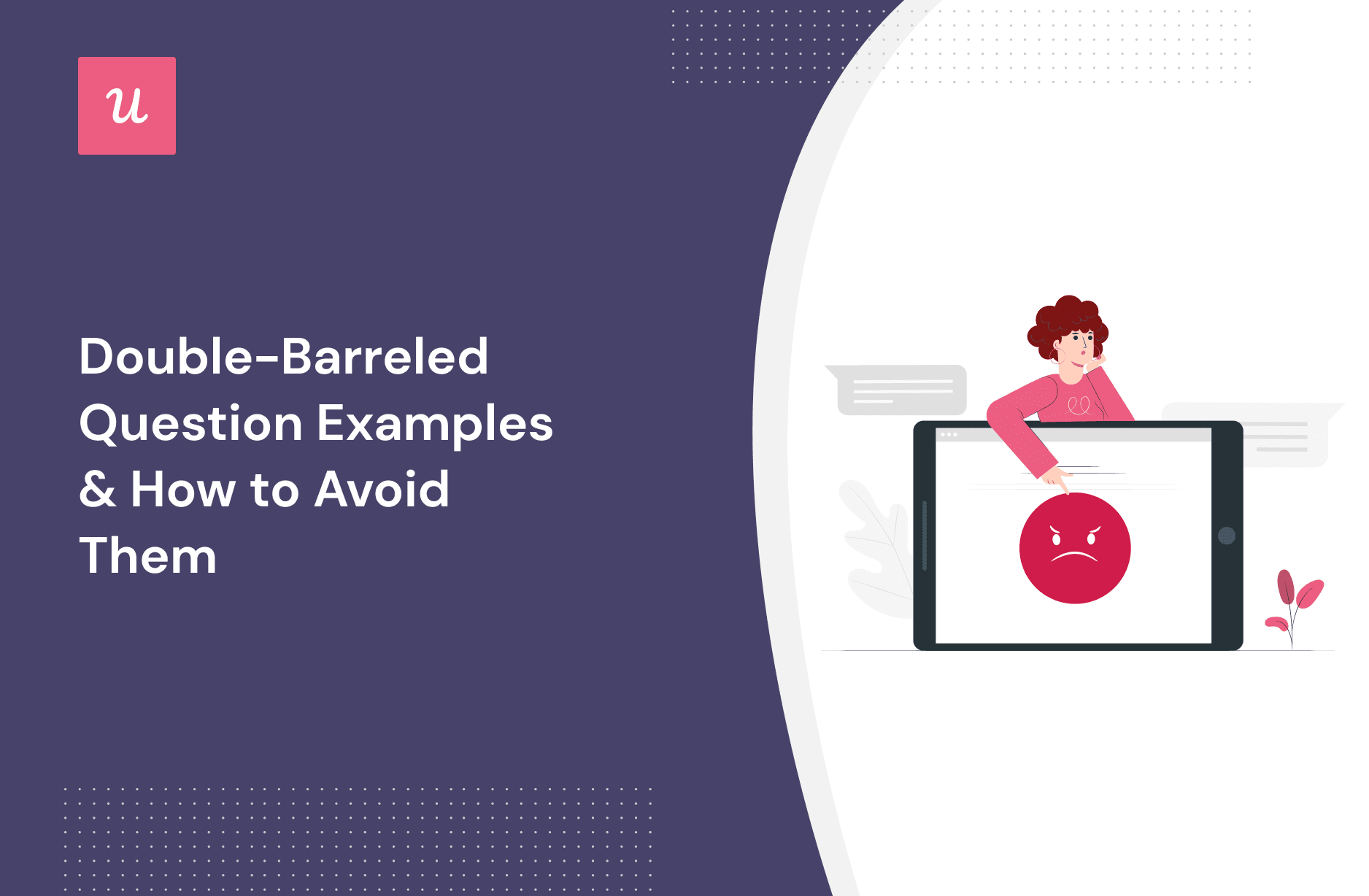
Double-Barreled Question Examples & How to Avoid Them
Learning to identify double-barreled question examples is key to avoiding them in your surveys. To accurately capture user sentiment with your surveys, you must avoid any question that leads to confusion or frustration.
In this article, we examine what double-barreled questions are, why they’re harmful to your survey, and what you can do to avoid them. We also identify some examples so that these questions are easier to spot in the future.
Let’s begin!
Get The Insights!
The fastest way to learn about Product Growth, Management & Trends.
What is a double-barreled question?
A double-barreled question is an informal fallacy that combines two questions but allows for only one answer.
Also known as a double-direct question, a double-barreled question makes respondents uncertain about how to answer. And not everyone will answer this question in the same manner.

The consequences of double-barreled survey questions
Double-barreled questions combine two related or unrelated topics into one compound question requiring one answer, leading to:
- Confused respondents: Asking two questions in one leaves respondents confused about which question they’re answering. Are they answering the first question, the second question, or neither? This makes it difficult for them to provide meaningful and accurate responses.
- Unreliable results: Respondents may feel obligated to select an answer, even if the answer options do not represent their true opinion on the combined question. This leaves you with results you can’t rely on.
- Inaccurate interpretation: Double-barreled questions make it impossible to obtain accurate survey results or properly interpret those results. You simply can’t tell which aspect of the question influenced the response, thus making it challenging to analyze the responses.
Ultimately, double-barreled questions leave respondents with confusing questions and analysts with unreliable and inaccurate data. The result is a wasted survey that can lead to unwise business decisions.
How to identify double-barreled questions
Thankfully, double-barreled questions are often easy to identify. They typically appear in either of two forms:
- Compound questions: A compound question uses words like “and” or “or” to connect a series of questions while offering a single answer option.
- Ambiguous questions: Some questions may not contain the word “and,” but still manage to fuse two ideas. For instance, consider the question: “Agree or Disagree: I love this product because it is easy to use.” Although it avoids the word “and,” it still combines two subjects – love for the product and its ease of use.
Regardless of how you frame them, double-barreled questions are confusing questions. They force two ideas into one and should be avoided by all means.
Double-barreled questions examples
Still not sure what double-barreled questions look like? Let’s now consider some survey question examples and why they qualify as a double-barreled question.
1. “How satisfied are you with the user interface and overall functionality of our SaaS product?”
The user may consider the product interface to be poor and functionality to be high.
2. “On a scale of 1 to 10, how likely are you to recommend our SaaS solution to others and how would you rate the quality of our customer support?”
Your SaaS solution may be great despite your not-so-helpful customer support.
3. “Please rate the ease of integration with our SaaS platform and the responsiveness of our technical support team.”
Although third-party integrations on your platform may be a pain, the technical support you provide may be top-notch.
4. “To what extent do you agree or disagree that our SaaS product meets your business needs and has a user-friendly interface?”
Your product could have a user-friendly interface without meeting the user’s needs and vice-versa.
5. “How frequently do you encounter software bugs or glitches, and how satisfied are you with the speed of issue resolution by our support team?”
Despite the use of “and” here, there are two separate questions lumped here as one.
Do you notice the pattern? Other similar questions include:
6. “Rate the effectiveness of our SaaS product in improving your team’s productivity and the clarity of our documentation and online resources.”
7. “Please indicate your level of agreement or disagreement with the statement: ‘Our SaaS solution provides excellent value for the price and has a comprehensive set of features.'”
8. “How well does our SaaS product address your specific industry requirements and how satisfied are you with the availability of new updates and features?”
9. “Rate the performance and reliability of our SaaS platform, as well as the promptness of our customer service team in handling your inquiries.”
10. “To what extent do you agree or disagree that our SaaS solution has a user-friendly interface and effectively meets your organization’s security and compliance needs?”
How to avoid double-barreled questions and improve the survey experience
Even the best-intentioned survey creators can unwittingly create a double-barreled question. However, there are simple steps you can follow to avoid double-barreled questions.
Write simple, straight-to-the-point, and easy-to-understand questions
Frame your questions carefully so that they’re simple and to the point. Don’t complicate things. The easier the question is to understand, the more accurate its results.
Split up survey questions into separate questions not to confuse survey respondents
Here’s the simplest tip for avoiding double-barreled questions – ask only one question at a time. For example, if you wanted to understand why users use your product, you could ask:
“How has Userpilot helped you achieve your goals and what are your main barriers to achieving these goals?”
For better clarity, however, you should break up the question like this:

Align the questions to your goals for accurate survey responses
Another way to avoid those types of questions will be to only ask questions that match up with your survey goals. For instance, if your goal is to understand user sentiment regarding a particular feature, your questions should be aligned.
You can’t, for example. ask a user what their role is and how they feel about a specific feature in one survey.
Use follow-up questions instead of overloading your survey respondents
Finally, you can improve your survey questions by following up close-ended questions with open-ended ones. This will give the respondent more room to expand on their perspective and give you more insight.
For instance, a simple NPS rating scale tells you how likely a customer is to recommend your product. Use an open-ended follow-up question to better understand why they gave their answer.

Common survey question errors to avoid
In addition to avoiding double-barreled questions, there are other question types you must also avoid to make your surveys more reliable.
Leading questions
A leading question uses non-neutral or subjective language to frame the context of a question.
For instance, the question: “What problems do you have with customer support?” leads you to think of the support you received from a negative angle.

Ambiguous questions
Ambiguous questions are generally broad and unclear, leading the respondent to guess what you have in mind. Questions of this nature can be interpreted differently by different people, leading to unreliable survey results.
For example, the question: “How do we compare to our competitors?” doesn’t specify the category of comparison. Is it in terms of product functionality, customer service, price, or what exactly?

Loaded questions
Unlike a double-ended question, a loaded question is assumptive. It makes assumptions about the respondent and forces them to respond based on the assumption, whether or not they agree with it.
For example the question: “How do we compare to our competitors?” assumes that your customers know enough about your competition to have an opinion.

Questions with biased language
Questions with biased language are framed to ensure the respondent answers affirmatively in favor of the survey creator. Like leading questions, it eliminates objectivity from its framing.
This is a common occurrence in Yes/No or Agree/Disagree questions, such as: “Is our customer service satisfactory? – Yes/No.”

Double negative questions
A double negative question uses two negatives in the same question. Due to the confusing wordplay employed in double negatives, they are often very confusing.
For instance, answering ‘Yes’ to the question below means you found an issue with the app’s interface.

Survey questions with poor answer scale
Ensure your answer scale is good enough to capture every user’s thoughts.
For example, while the Yes/No scale works well for the above question, it doesn’t work well with questions where responses may or may not be absolute.

Conclusion
Carefully examining your questions before publishing can help you catch any double-barreled questions before publishing your survey. Always remember that the best survey question is understood similarly by all respondents.
Once you’ve crafted your survey questions, Userpilot provides you with tools to launch the surveys right in your product and track both its performance and responses. Book a demo today to learn more.




